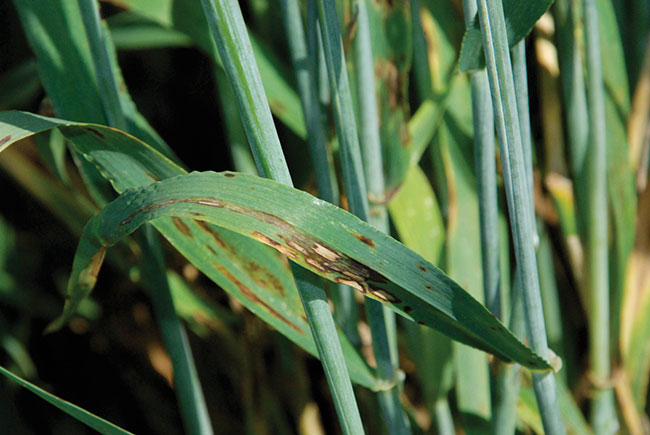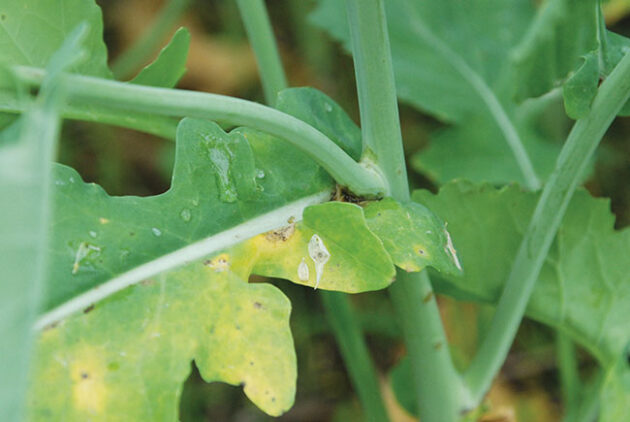
Features
Diseases
Prairie disease reporting tool launched
Tool crowd-sources information on disease development.
March 31, 2023 By Bruce Barker
 The Quick Disease Reporter Tool will help keep track of disease development, such as barley scald.
All Photos courtesy of .BRUCE BARKER.
The Quick Disease Reporter Tool will help keep track of disease development, such as barley scald.
All Photos courtesy of .BRUCE BARKER. A new disease reporting tool provides agronomists and farmers a heads-up on disease development. The Quick Disease Reporter Tool (QDRT) is a complementary tool to the Prairie Crop Disease Monitoring Network (PCDMN). It is supported by field crop pathologists who conduct research and monitor disease development to support field crop disease awareness and management on the Canadian Prairies. The network includes researchers from Agriculture and Agri-Food Canada, Manitoba Agriculture and Resource Development, Saskatchewan Agriculture, Alberta Agriculture and Forestry as well as Prairie-based universities.
“The Prairie Crop Disease Monitoring Network is a prairie-wide, co-ordinated plant disease monitoring program designed to keep the agriculture industry informed of field crop disease
issues,” says research scientist Kelly Turkington at AAFC Lacombe, Alta. He is the current PCDMN project lead and works with AAFC colleagues from Saskatoon and Swift Current. In addition, the three Prairie provincial plant pathologists are key collaborators.
The PCDMN highlights and creates awareness of field crop disease issues and their effective management. The website includes resources on scouting, surveillance protocols and a blog that highlights various diseases throughout the growing season (prairiecropdisease.blogspot.com). PCDMN is modelled after the long-running Prairie Pest Monitoring Network for insect pests and beneficial species.
The reporting tool was initially launched in June 2021 to provide crowd-sourced disease surveillance. It can be used to make general disease occurrence reports for Prairie field crops.
“The reporting tool provides a timely heads-up where disease outbreaks are starting to occur,” says Turkington. “It indicates where further in-crop scouting and risk assessments are needed as part of the process of assessing fungicide need and timing.”
Within the reporting tool, farmers and agronomists can submit photos of the disease observed by the province and municipality. A photo submission is mandatory in order to verify the disease.
Turkington and AAFC Geomatic colleague Matthew McBurney have been busy updating the app to address functionality, features and privacy concerns. The initial app was based on entering the GPS location of the field, which was then used to issue reports on a municipality basis. This, for many growers, will represent a privacy concern. Matthew then adjusted the app so reports were submitted on a municipality basis. Here, the app has drop down lists for province and then municipality. To speed things up, growers or consultants can enter the first few letters of the municipality where the field report is from and the app will automatically bring up the municipality or options with similar names.
An updated tutorial guide will be available on the PCDMN blog in March 2023 and can be found by searching for “tutorial” using the “Search This Blog” feature, through notifications to PCDMN subscribers, and also via the PCDMN Twitter feed.

Sclerotinia stem rot is a major disease of canola.
Turkington cautions that while the reporting tool does not include field-specific locations, there can be an issue with submitted photos being geo-tagged by the smartphone. This is an independent setting from the reporting tool app, and if privacy is a concern, he encourages users to turn off geo-location on their smartphone before taking photos.
“Another option would be to remove plant samples from the field and take a picture at a neutral location in the same municipality,” says Turkington.
Observations are compiled and the intent is to develop weekly or bi-weekly maps that will be posted on the blog along with scouting and risk assessment recommendations.
The Prairie Crop Disease Monitoring Network and the PCDMN QDRT has a terms of use that it will not share, or otherwise make available, any identifiable information regarding the submitter or location without the expressed permission of the submitter. The PCDMN QDRT is only to be used for reporting Canadian Prairie crop disease observations for the current growing season.
The PCDMN first took shape under the Integrated Crop Agronomy Cluster (2018-2023) and is funded through the Canadian Agricultural Partnership. The Cluster is led by Western Grains Research Foundation in partnership with the Saskatchewan Canola Development Commission, Alberta Wheat Commission, Saskatchewan Wheat Development Commission, Alberta Pulse Growers, Saskatchewan Pulse Growers, Manitoba Pulse and Soybean Growers, Manitoba Wheat and Barley Growers Association and Agriculture and Agri-Food Canada.
Turkington emphasizes that with more farmers and agronomists using the reporting tool, better information will be gathered and the resulting disease occurrence maps that are generated by the PCDMN will be more valuable. In 2021 and 2022, there were a limited number of users with the reporting tool, which may have been related to 2021 drought, privacy concerns or simply not being aware of the tool and what it can help with in terms of identifying emerging Prairie disease issues. He hopes that number will grow in 2023.
“More people contributing will mean better information and a better heads up for emerging problems,” he says.